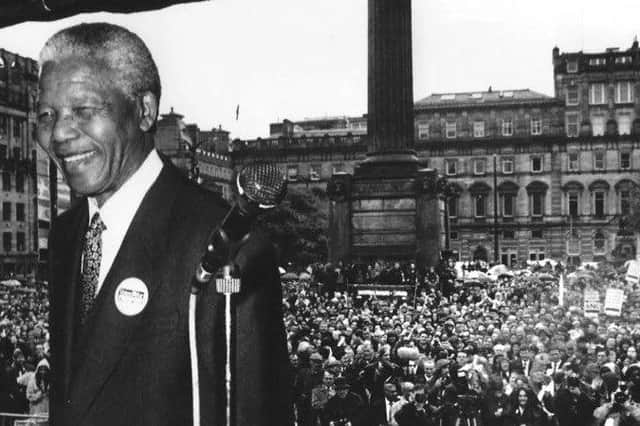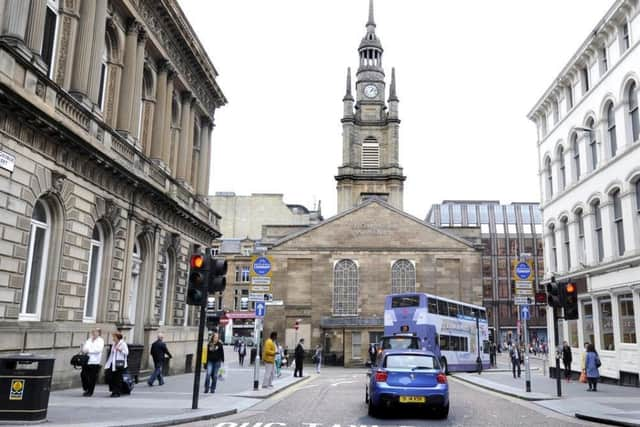New education resource explores Nelson Mandela’s links with Scotland


Mandela, who died in 2013, came to the city a year before becoming president of the Republic of South Africa and not long after being released from three decades in prison to thank Glaswegians for their support opposing apartheid. Glasgow had honoured him in 1986 when St George's Place, the location of the South African consulate-general, was renamed Nelson Mandela Place.
The former South African president also received similar honours from eight other parts of the UK including Aberdeen, Dundee and Midlothian District.
Many years later the Scottish anti-apartheid movement is supporting school children in learning more about prejudice and discrimination. The West of Scotland Development Education Centre (WOSDEC) has collaborated with the Nelson Mandela Scottish Memorial Foundation to create a new learning resource.


Named 'When Nelson Mandela danced in the square', the resource for Scottish teachers explores apartheid in South Africa and the Scottish anti-apartheid movement. It also looks at contemporary racism, framed within the key question: “What would Mandela think today?”.
WOSDEC is one of five Development Education Centres (DECs) within the International Development Education Association of Scotland (IDEAS) that deliver training and support for teachers. IDEAS is the Scottish partner organisation for Bridge 47, an EU-funded project operating across 12 European countries, including Scotland, to promote Global Citizenship Education.
Brian Filling, chair of the Nelson Mandela Scottish Memorial Foundation and honorary consul for South Africa in Scotland, campaigned against apartheid for many years and was behind Mandela's Glasgow visit. The Foundation was established after Mandela's death with two main aims.
He explains: “The foundation was set up to try to get a statue of Mandela erected in Glasgow and with a second and equal aim to conduct educational work about his life and legacy.”
Filling adds that it's important for the deep historical link between Scotland and South Africa, both good and bad, to be understood. He explains that Scotland was involved in colonialism and many Scots were “on the wrong side”. But Scots also did worthwhile educational work in South Africa, including being part of the foundation of the University of Fort Hare attended by Mandela.
The new education resource takes its name from the song, 'Mandela danced in the square' written by Ian Davison to mark Mandela's visit to Glasgow. South African singer Mara Louw had also been invited to the city where she sang and danced with Mandela on stage.
Filling says: “From the platform looking at the crowd on George Square it was a really dreich day, but when they danced it was as if the sun shone.”
Kim McAuley, a global education adviser at WOSDEC, says: “When the Foundation approached us we understood how rich this story was of people in west of Scotland, and the country more widely, being passionately motivated to do something to support the people of South Africa living under the apartheid regime.
“The resource explores the historical context, looks at Mandela's life, the reasons for apartheid and tries to give an experiential learning insight into what living under this regime would have been like.
“We were keen to ensure we made links to ongoing examples of discrimination, xenophobia and racism that are reality today.”
Diana Ellis, a global education adviser at WOSDEC, says: “Inspiration comes from children developing history skills and looking at a timeline of Mandela's life. Children can see strong and powerful images from South Africa during apartheid and video footage of Mandela in George Square. For kids in Glasgow in particular it's inspirational it happened in their square.”
She adds that some of the content for later sections of the resource are data driven, exploring such issues as hate crime in Scotland, and are focused on developing literacy and numeracy skills. The section on the life of Mandela looks at how effective his speeches were and asks children to write about something they care passionately about.
Lessons are linked to the Sustainable Development Goals and relevant articles from the UN Convention on the Rights of the Child.
Answering the question “what would Mandela think today?”, Filling believes he would be disappointed by evidence of racism emerging in South Africa. He adds: “I think he would have shared our view that the struggle against racism is a continuous one.”
The publication of the new resource is timely given the global prominence of the Black Lives Matter movement against racism which has also highlighted Glasgow's historic role in the slave trade.
Ross Isdale, development manager at the Scottish Fair Trade Forum, concludes: “The legacy of the slave trade is still evident within Scotland today; not only in the names of our streets and buildings, but in the attitudes we have to human rights and our supply chains.
“Embedding fair trade within our school curriculum remains crucial for helping our young people develop their understanding of the socio-economic challenges that remain pervasive today. ”
This article was funded by the European Union